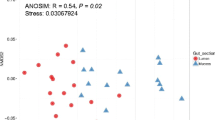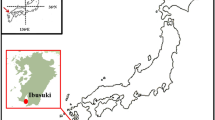Abstract
In this study, we used a 16S rDNA–based approach to determine bacterial populations associated with coho salmon (Oncorhynchus kisutch) in its early life stages, highlighting dominant bacteria in the gastrointestinal tract during growth in freshwater. The present article is the first molecular analysis of bacterial communities of coho salmon. Cultivability of the salmon gastrointestinal microbiota was estimated by comparison of direct microscopic counts (using acridine orange) with colony counts (in tryptone soy agar). In general, a low fraction (about 1%) of the microbiota could be recovered as cultivable bacteria. Using DNA extracted directly from individuals belonging to the same lot, bacterial communities present in eggs and gastrointestinal tract of first-feeding fries and juveniles were monitored by polymerase chain reaction–denaturing gradient gel electrophoresis (PCR–DGGE). The DGGE profiles revealed simple communities in all stages and exposed changes in bacterial community during growth. Sequencing and phylogenetic analysis of excised DGGE bands revealed the nature of the main bacteria found in each stage. In eggs, the dominant bacteria belonged to β-Proteobacteria (Janthinobacterium and Rhodoferax). During the first feeding stage, the most abundant bacteria in the gastrointestinal tract clustered with γ-Proteobacteria (Shewanella and Aeromonas). In juveniles ranging from 2 to 15 g, prevailing bacteria were Pseudomonas and Aeromonas. To determine the putative origin of dominant Pseudomonas and Aeromonas found in juvenile gastrointestinal tracts, primers for these groups were designed based on sequences retrieved from DGGE gel. Subsequently, samples of the water influent, pelletized feed, and eggs were analyzed by PCR amplification. Only those amplicons obtained from samples of eggs and the water influent presented identical sequences to the dominant bands of DGGE. Overall, our results suggest that a stable microbiota is established after the first feeding stages and its major components could be derived from water and egg epibiota.


Similar content being viewed by others
References
Amann, R, Ludwing, W, Scheifer, K (1995) Phylogenetic identification and in situ detection of individual microbial cells without cultivation. Microbiol Rev 59: 143–169
Austin, B, Al-Zahnari, AMJ (1988) The effect of antimicrobial compounds of the gastrointestinal microflora of rainbow trout, Salmo gairdneri Richardson. J Fish Biol 33: 1–14
Austin, B (2002) The bacterial microflora of fish. The Scientific World Journal 2: 558–572
Berg, R (1996) The indigenous gastrointestinal microflora. Trends Microbiol 4: 430–435
Beveridge, M, Begum, M, Frerichs, G, Millar, S (1989) The ingestion of bacteria in suspension by the tilapia Oreochromis niloticus. Aquaculture 81: 373–378
Buddington, R, Weiher, E (1999) The application of ecological principles and fermentable fibers to manage the gastrointestinal tract ecosystem. J Nutr 129: 1150S–1446S
Cahill, M (1990) Bacterial flora of fishes: a review. Microb Ecol 19: 21–41
Cole, J, Chai, B, Farris, R, Wang, Q, Kulam, S, McGarrell, D, Garrity, G, Tiedje, J (2005) The Ribosomal Database Project (RDP-II): sequences and tools for high-throughput rRNA analysis. Nucleic Acids Res 33: D294–D296
Crump, B, Armbrust, E, Baross, J (1999) Phylogenetic analysis of particle-attached and free-living bacterial communities in the Columbia River, its estuary, and the adjacent coastal ocean. Appl Environ Microbiol 65: 3192–3204
De Long, E (1992) Archaea in coastal marine environments. Proc Natl Acad Sci USA 89: 5685–5689
Espejo, R, Escanilla, D (1993) Detection of HIV1 DNA by a simple procedure of polymerase chain reaction, using “primer–dimer” formation as an internal control of amplification. Res Virol 144: 243–246
Espejo, R, Feijoo, C, Romero, J, Vásquez, M (1998) PAGE analysis of the heteroduplexes formed between PCR-amplified 16S rRNA genes: estimation of sequence similarity and rDNA complexity. Microbiology 144: 1611–1617
Finneran, K, Johnsen, C, Lovley, D (2003) Rhodoferax ferrireducens sp. nov., a psychrotolerant, facultatively anaerobic bacterium that oxidizes acetate with the reduction of Fe (III). Int J Syst Evol Microbiol 53: 669–673
Griffiths, S, Melville, K, Cook, M, Vincent, S, Pierre, M, Lanteigne, C (2001) Profiling of bacterial species associated with haddock larviculture by PCR amplification of 16S rDNA and denaturing gradient gel electrophoresis. J Aquat Anim Health 13: 355–363
Hansen, G, Olafsen, J (1999) Bacterial interaction in early life stage of marine cold water fishes. Microb Ecol 38: 1–26
Holben, WE, Williams, P, Saarinen, M, Sarkilahti, LK, Apajalahti, JH (2002) Phylogenetic analysis of intestinal microflora indicates a novel mycoplasma phylotype in farmed and wild salmon. Microb Ecol 44: 175–185
Hooper, L, Midtvedt, T, Gordon, J (2002) How host–microbial interactions shape the nutrient environment of the mammalian intestine. Annu Rev Nutr 22: 283–307
Horsley, R (1977) A review of the bacterial flora of teleosts and elasmobranchs, including methods for its analysis. J Fish Biol 10: 529–553
Huber, I, Spanggaard, B, Appel, K, Rossen, L, Nielsen, T, Gram, L (2004) Phylogenetic analysis and in situ identification of the intestinal microbial community of rainbow trout (Oncorhynchus mykiss, Walbaum). J Appl Microbiol 96: 117–132
Jensen, S, Bergh, O, Enger, O, Hjeltnes, B (2002) Use of PCR-RFLP for genotyping 16S rRNA and characterizing bacteria cultured from halibut fry. Can J Microbiol 48: 379–386
Jensen, S, Ovreas, L, Bergh, O, Torsvik, V (2004) Phylogenetic analysis of bacterial communities associated with larvae of the Atlantic halibut propose succession from a uniform normal flora. Syst Appl Microbiol 27: 728–736
Macfarlane, G, Macfarlane, S (1997) Human colonic microbiota: ecology, physiology and metabolic potential of intestinal bacteria. Scand J Gastroenterol 222: 3–9
Mackie, R, Sghir, A, Gaskins, H (1999) Developmental microbial ecology of the neonatal gastrointestinal tract. Am J Clin Nutr 69: 035S–045S
McCracken, V, Simpson, J, Mackie, R, Gaskins, H (2001) Molecular ecological analysis of dietary and antibiotic-induced alterations of the mouse intestinal microbiota. J Nutr 131: 1862–1870
Munro, P, Babour, A, Birkbeck, T (1994) Comparison of the gut bacterial flora of start-feeding larval turbot under different conditions. J Appl Bacteriol 77: 560–566
Muyzer, G, De Waal, EC, Uitterlinden, GA (1993) Profiling of complex populations by denaturating gradient gel electrophoresis analysis of polymerase chain reaction-amplified genes coding for 16S rRNA. Appl Environ Microbiol 66: 2578–2588
Olafsen, J (2001) Interactions between fish larvae and bacteria in marine aquaculture. Aquaculture 200: 223–247
Rawls, J, Samuel, B, Gordon, J (2004) Gnotobiotic zebrafish reveal evolutionarily conserved responses to the gut microbiota. Proc Natl Acad Sci USA 101: 4596–4601
Reardon, C, Cummings, D, Petzke, L, Kinsall, B, Watson, D, Peyton, G, Geesey, G (2004) Composition and diversity of microbial communities recovered from surrogate minerals incubated in an acidic uranium-contaminated aquifer. Appl Environ Microbiol 70: 6037–6046
Ringo, E, Strom, E, Tabachek, J (1995) Intestinal microflora of salmonids. Aquacult Res 26: 773–789
Ringo, E, Birkbeck, T (1999) Intestinal microflora of fish larvae and fry. Aquacult Res 30: 73–93
Romero, J, Espejo, R (2001) The prevalence of non-cultivable bacteria in oysters (Tiostrea chilensis, Philippi 1845). J Shellfish Res 20: 1235–1240
Romero, J, Garcia-Varela, M, Laclette, J, Espejo, R (2002) Bacteria clustering with Arcobacter spp. constitute an abundant and common component of the oyster microflora (Tiostrea chilensis). Microb Ecol 44: 365–371
Rozen, S, Skaletsky, H (2000) Primer3 on the www for general user and for biologist programmers. In: Krawetz, S, Misener, S (Eds.) Bioinformatics Methods and Protocols. Humana Press. Totowa, pp 365–386
Schafer, H, Muyzer, G (2001) Denaturing gradient gel electrophoresis in marine microbial ecology. In: Paul, J (Ed.) Methods in Microbiology, Marine Microbiology. Academic Press. London, pp 425–468
Schiffrin, E, Blum, S (2002) Interactions between the microbiota and the intestinal mucosa. Eur J Clin Nutr 56: S60–S64
Spangaard, B, Huber, I, Nielsen, J, Nielsen, T, Appel, K, Gram, L (2000) The microflora of rainbow trout: a comparison of traditional and molecular identification. Aquaculture 182: 10–15
Stevens, C, Hume, I (1998) Contributions of microbes in vertebrate gastrointestinal tract to production and conservation of nutrients. Physiol Rev 78: 393–427
Suau, A, Bonnet, R, Sutren, M, Godon, J, Gibson, G, Collins, J, Dore, J (1999) Direct analysis of genes encoding 16S rRNA from complex communities reveals many novel molecular species within the human gut. Appl Environ Microbiol 65: 4799–4807
Sugita, H, Miyajima, C, Deguchi, Y (1991) The vitamin-B12-producing ability of the intestinal microflora of fresh-water fish. Aquaculture 92: 267–276
Sugita, H, Tanaka, K, Yoshinami, M, Deguchi, Y (1995) Distribution of Aeromonas species in the intestinal tracts of river fish. Appl Environ Microbiol 61: 4128–4130
Trust, T, Sparrow, R (1974) The bacterial flora in the alimentary tract of freshwater salmonid fishes. Can J Microbiol 20: 1219–1228
Van de Peer, Y, De Wachter, R (1997) Construction of evolutionary distance trees with TREECON for Windows: accounting for variation in nucleotide substitution rate among sites. Comput Appl Biosci 13: 227–230
Verner-Jeffreys, D, Shields, R, Bricknell, I, Birkbeck, T (2003) Changes in the gut-associated microflora during the development of Atlantic halibut (Hippoglossus hippoglossus L.) larvae in three British hatcheries. Aquaculture 219: 21–42
Verschuere, L, Rombaut, G, Sorgeloos, P, Verstraete, W (2000) Probiotic bacteria as biological control agents in aquaculture. Microbiol Mol Biol Rev 64: 655–671
Acknowledgments
This project was supported by grant DID INC 03/07-2 from the University of Chile. P. Navarrete acknowledges a scholarship from the Comisión Nacional de Ciencia y Tecnología CONICYT–Chile. The authors thank Harriet V. Harrison and Dr. Mariana Cifuentes for editing and revising the English grammar, R.T. Espejo for his helpful discussions and review, and Dr. Rafael Opazo for technical assistance.
Author information
Authors and Affiliations
Corresponding author
Rights and permissions
About this article
Cite this article
Romero, J., Navarrete, P. 16S rDNA-Based Analysis of Dominant Bacterial Populations Associated with Early Life Stages of Coho Salmon (Oncorhynchus kisutch). Microb Ecol 51, 422–430 (2006). https://doi.org/10.1007/s00248-006-9037-9
Received:
Accepted:
Published:
Issue Date:
DOI: https://doi.org/10.1007/s00248-006-9037-9




